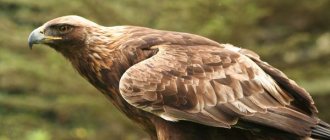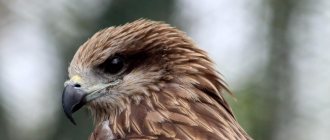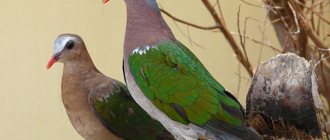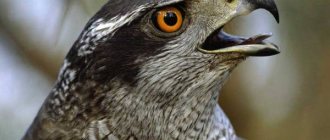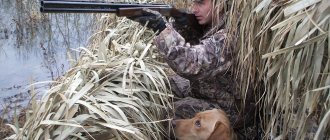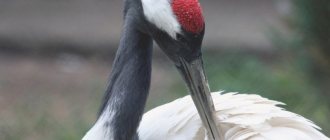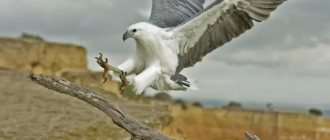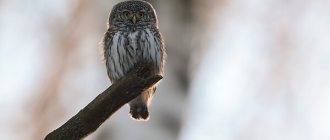- Wild animals
- >>
- Birds
The dwarf eagle is the smallest member of the hawk family and, according to some, the most attractive. Despite the name, the bird does not belong to the eagle family. Their build is more similar to that of buzzards. Unlike the falcon, they hunt not only in the sky, but also on the ground. The difference with kites is their habit of nesting on rocks.
Origin of the species and description
Photo: Eagle-dwarf
The species was first described by the German botanist I. F. Gmelin in 1788. The Russian name fully justifies the size and proportions of the predator. The species Aquila pennata (Hieraaetus pennatus) belongs to a small division and includes only 2 subspecies: the common dwarf eagle and the Caucasian dwarf eagle. The first is characterized by dark plumage, the second - lighter.
A molecular study by German scientists conducted in the early 2000s showed that all species of the genus Hieraaetus belong to one monophyletic group. Thus, the Aquila group is considered the common ancestor of all existing species. According to the study, almost all species that are characterized by small size must be included in the central genus Aquila.
Video: Dwarf Eagle
All Slavic names for birds come from Proto-Slavic. Those have an Indo-European root. The Indo-Europeans attached special significance to creatures. The Latin aquila is related to the word aqua (water). Because of their name, birds evoke rather controversial feelings. Most people associate the eagle with a large predator, such as a golden eagle or a bald eagle.
The word “dwarf” certainly does not correspond to the appearance of a stern, dangerous bird. However, the creature should not be underestimated. The small size is compensated by powerful paws with tenacious claws and a sharp beak. Previously, the species was classified as a member of the genus of hawk eagles, birds with similar characteristics, due to unusually narrow wings and a long tail.
Notes
- ↑ Boehme R.L., Flint V.E.
Five-language dictionary of animal names. Birds. Latin, Russian, English, German, French. / under the general editorship of academician. V. E. Sokolova. - M.: Rus. lang., "RUSSO", 1994. - P. 45. - 2030 copies. — ISBN 5-200-00643-0 - ↑ 12
Mullarney et al, p.82 - ↑ 123
Ryabitsev, S.123 - ↑
Ivanov et al., p.174 - ↑
Helbig et al, pp.147-164 - ↑ I. Kh. Dvoretsky
The meaning of the word pennatus.
Dvoretsky's Latin-Russian Dictionary (electronic version)
. linguaeterna.com. Archived from the original on April 11, 2012. Retrieved November 23, 2009. - ↑
Gensbøl, S.348 - ↑
Stepanyan, S.95 - ↑ 12
Thiollay, 1994 - ↑ 12345678
Gensbøl, pp.166-168 - ↑ 1 2 I. Karyakin
Dwarf eagle (Hieraaetus pennatus).
Species Sketches
. Server for environmental organizations of Southern Siberia. Archived from the original on April 11, 2012. Retrieved November 25, 2009. - ↑ 123
Martin, pp.535-536 - ↑
Booted Eagle.
Raptors Namibia
. Namibia Nature Foundation. Archived from the original on April 11, 2012. Retrieved November 24, 2009. - ↑ 123
Dementyev, Gladkov, 1951 - ↑
Baranov, 1991 - ↑ Andrey N. Baikalov
Dwarf Eagle.
Birds of Central Siberia
. birds.krasu.ru. Archived from the original on April 11, 2012. Retrieved November 26, 2009. - ↑
Suarez, 2000 - ↑ I. Karyakin
Dwarf eagle (Hieraaetus pennatus).
Species Sketches
. Server for environmental organizations of Southern Siberia. Archived from the original on April 11, 2012. Retrieved November 22, 2009.
Appearance and features
Photo: What a dwarf eagle looks like
Despite his eagle-like appearance, the dwarf's physique is no larger than a kite. Females are significantly larger than males.
The sizes of adult predators are quite modest:
- length - 47-53 cm;
- wing length - 34-36 cm;
- wingspan - 105-130 cm;
- tail length - 17-19 cm;
- weight - 550-1100 g.
The color of females and males is the same. You can meet a light-colored or dark-colored eagle. Light-colored individuals are distinguished by brown upperparts and dirty gray underparts. Brown streaks run across the chest. Birds with dark plumage are equally brownish-brown both above and below.
The head is golden in color, which is typical for other species. The tail of birds below is always light, without transverse stripes. There are 6 toes on the paws, unlike the buzzard, which has only 5. However, the birds do not spread their toes as much as their relatives.
In flight, the dwarf can be confused with the honey beetle; they can only be distinguished by their rounded tail. The honey beetle's is cut evenly. The head of individuals of this species is large, the beak is black and short, curved and powerful, the paws are strong, shaggy up to the tarsus itself. The flight, like that of other eagles, is smooth, in a straight line.
Fingers are yellow, claws are black. The voice resembles a shrill whistle. During the breeding season, a squawk characteristic of the genus is heard. Dwarfs are excellent flyers. In flight, they gain quite high speed. In the natural environment, under favorable conditions, birds live up to 25 years, in captivity - up to 30-32 years.
syn. Hieraaetus pennatus
Photo © Vicente Zumel / Wikimedia Commons.
Burgos (España). CC BY-SA 3.0 Registrations since 2000:
Brest region – Lyakhovichi, Stolin districts
Gomel region – Zhitkovichi district
Grodno region – Svisloch district
Minsk region – Minsk district
Accipitridae family – Accipitridae
In Belarus – A. p. pennatus (the subspecies inhabits the entire European part of the species' range).
Breeding migratory and transit migratory species. Very rare, the species nests only in the south of the republic (in Belovezhskaya Pushcha and Gomel Polesie). The northern border of its distribution lies on the territory of the republic.
A small eagle with agile flight, very agile. The wings are large and rather narrow. There are two types of plumage color that are not related to gender and age. Birds of the dark type have entirely dark brown plumage on top and bottom, with a slightly lighter head and neck. In birds of the light type, the plumage of the underparts is white or light buffy, with longitudinal streaks; The lower wing coverts are of the same color (contrasting with the dark brown flight feathers). The beak of all birds is black, the wax and toes are yellow. Male weight 660-730 g, female 820-963 g. Body length (both sexes) 47-56 cm, wingspan 107-135 cm.
Arrives in April.
Data on the biology of this species in Belarus are fragmentary.
Settles in old tall coniferous-deciduous or broad-leaved forests bordering meadows, clearings, and overgrown with bushes. It nests in single pairs on trees of various species at a height of 8 to 22 m. Sometimes it builds its own nests, but more often it uses the buildings of other large birds (buzzard, goshawk, black stork, gray heron, etc.). Only 5 nests of this bird have been found in the republic. Three of them were found with chicks in the 1950s in Belovezhskaya Pushcha, the rest until the 1980s in the Gomel region. One was located in a small island area of broad-leaved forest (oak, ash, maple), among extensive wet alder, on the side branch of an old oak tree, 17 m from the ground and half a meter from the trunk. It was previously owned by a black stork, which reoccupied it the following year. Another was built in an oak-pine forest, not far from a stream, also on an oak tree, at a height of 8 m (taken from a buzzard; its egg was found under the nest). The height of its own nest is 43-50 cm, diameter 95-105 cm; tray depth 7 cm.
There are usually 2 eggs in a clutch, rarely 1 or 3. The shell is matte, rough, white or greenish-white, sometimes with faintly visible brownish spots. Egg weight 60 g, length 55 mm, diameter 42-44 mm.
Egg laying occurs in late April - early May. There is one brood per year. The female incubates for 30 days (according to other observations, 35-38). The chicks become flightable in the first half of August.
In September the birds fly away for the winter.
The basis of food consists of medium-sized birds - from thrush to black grouse; Smaller animals (squirrel, water rat, voles) are eaten less frequently.
A very rare bird. The number in Belarus is estimated at 10–15 breeding pairs.
The species has been listed in the Red Book of Belarus since 1981.
Literature
1. Grichik V.V., Burko L.D. “Animal world of Belarus. Vertebrates: textbook. manual” Minsk, 2013. -399 p.
2. Nikiforov M. E., Yaminsky B. V., Shklyarov L. P. “Birds of Belarus: A guide to nests and eggs” Minsk, 1989. -479 p.
3. Gaiduk V. E., Abramova I. V. “Ecology of birds in the southwest of Belarus. Non-passeriformes: monograph.” Brest, 2009. -300s.
4. Dombrovski V. Ch., Ivanovski V. “New data on numbers and distribution of birds of prey breeding in Belarus” / Acta Zoologica Lituanica. 2005 – Vol. 15(3). P.218–227.
5. Dombrovsky V. Ch. “Dwarf Eagle” / Red Book of the Republic of Belarus. Animals: rare and endangered species of wild animals. 4th ed. Minsk, 2015. P.66-67
6. Nikiforov M. E., Samusenko I. E. “Finds and encounters of birds, approved by the Belarusian Ornitho-Faunistic Commission on December 14, 2004.” / Subbuteo 2004, volume 7 P.57-64
7. Nikiforov M. E., Samusenko I. E. “Finds and sightings of birds, approved by the Belarusian Ornitho-Faunistic Commission on December 16, 2009.” / Subbuteo No. 10, 2011. P.70-77
8. Minutes of the meeting of the BOFK No. 3 (2018) dated 04/03/2018.
InterpretationTranslation
Pygmy Eagle >
| Pygmy eagle | |
| Scientific classification | |
| Kingdom: | Animals |
| Type: | Chordata |
| Class: | Birds |
| Squad: | Falconiformes |
| Family: | Accipitridae |
| Genus: | Eagles |
| View: | Pygmy eagle |
- Hieraaetus pennatus
- Aquila minuta
Brehm, 1831
All year round
Winter migration
| International Red Book IUCN 3.1 Least Concern : 106003543 |
Eagle-dwarf
[1] (lat.
Aquila pennata
, syn. lat.
Hieraaetus pennatus
) - a bird of prey of the hawk family, a small eagle, with a physique and size closer to buzzards. Breeds in the north-west and extreme south of Africa and in the warm temperate climate of Eurasia. In Russia, it is distributed in the south of the European part and in parts of Central Siberia adjacent to Mongolia. A migratory bird almost everywhere, winters in the tropics of Africa and South Asia. Hunts small birds, lizards, snakes, rodents. It nests in trees in the forest once a year; a clutch usually contains one or two eggs.
Where does the dwarf eagle live?
Photo: Dwarf eagle in Russia
The habitat includes most of Europe - Spain, France, Mongolia, Transbaikalia. They live in South Africa and Central Asia. In a significant part of the range, only migratory birds can be found. Birds lead a sedentary lifestyle in India, Pakistan, and the Balearic Islands.
In northwest Africa it is found along the Mediterranean Sea. The largest populations live on the Iberian Peninsula. There are isolated concentrations of birds in Greece, Bulgaria, Turkey, Mongolia, Ukraine, and Belarus. In Russia, the range includes the Tambov and Tula regions, the Altai Territory, the Baikal region, and Transbaikalia.
Most European dwarfs migrate to Africa - forest-steppe or savannah. Lonely birds remain in the Middle East, Mallorca, Southern Europe, North America. Populations from the East fly to the Indian subcontinent. Flight through large bodies of water is carried out in narrow places. They fly away mainly in September and return at the end of March.
During nesting, they settle in the steppe and forest-steppe, deciduous, coniferous and mixed forests, near open wetlands. They also nest on the plain, but more often in hilly, foothill areas with sparse vegetation, at an altitude of up to 3 thousand meters above sea level. The ideal habitat is an arid oak forest located on a hill. If there is no forest nearby, they settle in areas near clusters of tall trees, near meadows and swamps. For wintering they go to the same habitats - steppes and forest-steppes, savannas.
The home is constantly updated with branches with green leaves. Nowadays, the nest is usually built on the trunk of deciduous trees - oak, elm, aspen. Previously, in most cases, the building was built on a pine tree. Sometimes nests can be located at a height of up to 20 meters.
Now you know where the dwarf eagle lives. Let's see what this bird eats.
Literature
- Benny Gensbøl
Collins Birds of Prey. - UK: HarperCollins, 2007. - pp. 166-168, 348. - 416 p. — ISBN 0007248148 (English) - James Ferguson-Lees, David A. Christie
Raptors of the World. - USA: Princeton University Press, 2007. - P. 252. - 320 p. — ISBN 0691126844 (English) - A. J. Helbig, A. Kocum, I. Seibold, M. J. Braun.
A multi-gene phylogeny of aquiline eagles (Aves: Accipitriformes) reveals extensive paraphyly at the genus level //
Molecular Phylogenetic Evolution
. - 2005. - T. 35. - No. 1. - P. 147-164. (English) - RJ Martin 2005.
Booted Eagle Aquila pennatus In: Hockey PAR, Dean WRJ, Ryan PG (eds.) Roberts Birds of Southern Africa. - Cape Town: Black Eagle Publishing, 2005. - pp. 535-536. — 1296 p. — ISBN 0620340533 (English) - Killian Mullarney, Lars Svensson, Dan Zetterström, Peter J. Grant
Birds of Europe. - United States: Princeton University Press, 2000. - P. 82. - 400 p. — ISBN 978-0-691-05054-6 (English) - Susana Suarez, Javier Balbontin, Miguel Ferrer.
Nesting Habitat Selection by Booted Eagles Hieraaetus pennatus and Implications for Management //
Journal of Applied Ecology
. - 2000. - T. 37. - No. 2. - P. 215-223. (English) - J. Thiollay 1994. Family Accipitridae (Hawks and Eagles) in del Hoyo, J., Elliott, A., & Sargatal, J., eds.
Vol. 2 New World Vultures to Guineafowl. // Guide to the birds of the world = Handbook of the birds of the world. - Barcelona: Lynx Editions, 1994. - pp. 52-105. — ISBN 84-87334-15-6 (English) - A. A. Baranov.
Rare and little-studied birds of Tuva. - Krasnoyarsk: Krasnoyarsk University Publishing House, 1991. - 320 p. - G. Dementyev, N. Gladkov.
Birds of the Soviet Union. - Soviet science, 1951. - T. 1. - A. I. Ivanov, E. V. Kozlova, L. A. Portenko, A. Ya. Tugarinov.
I // Birds of the USSR. - M.-L.: Publishing House of the USSR Academy of Sciences, 1951. - P. 174-175. — 280 s. - V.K. Ryabitsev.
Birds of the Urals, the Urals and Western Siberia: A reference guide. - Ekaterinburg: Ural Publishing House. University, 2001. - P. 123. - 608 p. — ISBN 5-7525-0825-8 - L. S. Stepanyan.
Abstract of the ornithological fauna of Russia and adjacent territories. - Moscow: Akademkniga, 2003. - 808 p. — ISBN 5-94628-093-7
What does the dwarf eagle eat?
Photo: Pygmy eagle in nature
These birds have no food preferences. They eat everything they can catch on the ground or in the air. The small size of the predator does not prevent it from hunting larger animals.
Strong legs, a powerful beak and sharp claws help birds catch fast-moving game, such as:
- hares;
- rabbits;
- mice;
- gophers;
- rats
On the ground or in flight, other birds can become prey for the dwarf eagle:
- sparrows;
- partridges;
- blackbirds;
- larks;
- starlings;
- magpies;
- turtle doves;
- woodlarks;
- corncrakes;
- pigeons.
Predators do not hesitate to destroy the nests of other birds. They hunt both from ambush, hiding in tree branches, and in flight, looking for prey from above. Seeing movement, the birds descend to a height of about 20 meters and fall down like a stone. They hit the victim in the neck or head with sharp claws. In arid areas, the main diet consists of lizards, snakes, frogs, and geckos.
Interesting fact: They do not disdain poisonous reptiles: with a precise movement of their sharp beak they hit the victim in the head. But sometimes such a hunt becomes death for the birds - the snake manages to bite the dwarf and he loses his sight or dies.
Sometimes, especially on wintering grounds, when there is a lack of prey, insects can make up up to 20% of the diet. The creatures give particular preference to termites. In the air, eagles manage to catch flying birds. Like their relatives, dwarfs are burial grounds and can pick up animal corpses from the ground.
Threats[edit]
The main threats to this species are the destruction and degradation of its feeding and breeding habitat, causing it to compete with the larger and more dominant wedge-tailed eagle Aquila audax
(Olsen and Fuentes, 2005). The wedge-tailed eagle is not necessarily a predator of the small eagle, but the two species share habitat and prey, and the large size and dominant nature of the wedge-tailed eagle may mean that the small eagle will be forced to abandon hunting and breeding. lands or even killed and eaten.
Features of character and lifestyle
Photo: Dwarf eagle bird
Birds spend most of their lives in flight. Less commonly, they are found sitting on a tree branch located on the edge of an open area, surveying the area. At high altitudes, creatures do not fly so as not to miss the movement of game. They hover low only to spook and detect animals. Southern populations like to hunt from bushes.
Nests are built when a pair is formed. They can reconstruct the nests of other birds. They set up a home at a fork in the trunks at a height of 7 meters. The diameter of the dwelling reaches one meter, the depth is about 15 centimeters. Branches and sticks are used for construction, and the bottom is lined with dried leaves and grass.
Interesting fact: Eagles are monogamous birds. The couple goes to warm countries together and returns together to the same nest. But they spend the wintering itself separately.
Acute vision allows the creatures to see prey at an altitude of up to 200 meters. In general, a predator's eyes are designed in such a way that if it sees a color picture, it will perceive it as millions of multi-colored dots, and not as a complete photograph. Birds are able to combine images from two eyes into one stereoscopic one.
Predators easily maneuver between the dense crowns of trees, managing not to touch a single branch. After a hunt, the prey is usually eaten immediately. The exception is when it is necessary to feed the offspring. After lunch, dwarfs drink a lot of water, and then carefully clean their feathers. Food can be stored in the crop of birds for several days. This makes it possible not to hunt every day.
Links
Other books on request “Dwarf Eagle” >>
HomeSouth of RussiaBirds listed in the Red Book Dwarf eagle
The pygmy eagle is a small bird that prefers to nest in tall trees in deciduous forests. The bird chooses a partner for life, arranging a common life. The bird population is on the verge of extinction.
The smallest eagle in the world is the pygmy eagle. It is slightly larger in size than a kite. Body weight does not exceed one kilogram. This species of bird has very diverse plumage. It can be yellow, brown, brown, gray. Ornithologists divide dwarf eagles into species based on color: dark, light and medium tone. The paws are strong with curved claws and feathered to the very bottom. The beak is large. Males are slightly larger than females.
Pygmy eagles have very good eyesight.
These birds are excellent hunters. They can sit on a tree for a long time, waiting for prey. When a victim appears, it goes into a sharp dive. The flight is fast, they rarely soar.
Pygmy eagles prefer to locate their nests in dense forests and thickets. They calmly move between thickets of trees due to their small size. They nest on deciduous trees. The female lays two eggs, which she and the male take turns incubating for a month. The chicks eat the same food as their parents. Usually these are small rodents and game.
Pygmy eagles also attack other nests in order to consume the eggs of other birds as food.
Birds fly to the countries of Africa, Asia and India for the winter.
Pygmy eagles are monogamous. Couples are united once for the rest of their lives. They winter together, fly to a nesting site, and build nests.
When building a nest, they use twigs and branches and line the bottom with leaves and dry grass. After the birds die, their nest can be occupied by the younger generation.
The lifespan of pygmy eagles is about 25 years.
GyrfalconGyrfalcon is a beautiful, white bird that belongs to the family of predatory falcons and the order Falconiformes.- Caucasian black grouse The Caucasian black grouse is a mountain bird, lives in the Caucasian ridge zone, at an altitude of up to 2200 above normal sea level.
Little Bustard Bird A bird from the bustard family and the crane-like order with an unusual, beautiful coloring.- Steppe eagle The steppe eagle is a proud, large and bird of prey, very beautiful, it is not for nothing that the image of an eagle is associated with courage, greatness and masculinity.
Related materials:
Black-throated loonCaucasian grouseSteppe eagleCrested cormorantHave you noticed an error or out-of-date information? Please let us know about it
Social structure and reproduction
Photo: Male and female pygmy eagle
During pair formation, birds perform mating dances. The male begins, soaring to a height of up to 800 meters. It falls exponentially and rises again. Sometimes performs a dead loop. At the end of mating, the female joins and the pair flies together. Immediately after this, nest construction begins.
Interesting fact: In addition to the concept of “swan fidelity,” there is also “eagle fidelity.” If suddenly one of the partners dies, the second waits one season, after which he makes attempts to find a partner and start a new family.
Eagles do not hide their presence at nesting sites. They squeal loudly or make vibrations like “chee-dee.” In mid-spring, the female lays and incubates 1-3 eggs that are white, yellow or green, speckled with brown. After 36-39 days, chicks of different ages appear. The babies are covered with white-yellow down, the wax and paws are light yellow, the iris is blue.
During the first days, the mother stays with the offspring all the time, warms the eaglets, and the father takes care of food. By the second half of July, all the babies are feathered. After a couple of months, the chicks can get food on their own, but do not leave the parent’s nest until the end of summer. At the beginning of autumn, young animals are the first to go to warmer regions; after 2 weeks, adults fly out after them.
Natural enemies of the dwarf eagle
Photo: Eagle-dwarf
Despite their strength and dexterity, birds are a vulnerable link in the ecological chain. Birds have very few natural enemies. The main ones are wolves, other, stronger individuals and humans. The eagle's food competitor is the kite, which takes prey from the dwarf at every opportunity.
One of the creatures' enemies is hunger. In search of larger game, birds go south, since some species of animals disappear from the flora, virgin lands are plowed open, and food becomes difficult for them to obtain. The cause of death was repeatedly caused by power lines when the couple tried to build their home on the poles.
The special structure of the wings allows the dwarf to soar high even during a hurricane, which makes the predator the ruler of the air element, whose main enemy is man. Extermination by humans has led to a significant decrease in the number of birds.
As a result of agricultural activities, landscapes change. Birds not only lack food themselves, the lack of food also affects their offspring. If there are several chicks in the nest, starvation leads to the survival of only one baby - the strongest. Poaching and the environmental situation negatively affect the population decline.
Population and species status
Photo: What a dwarf eagle looks like
In areas where deciduous forests are well preserved, the population reaches high densities. Nesting sites are located at a distance of about 200 meters from each other, there are 80-100 individuals per 2489 acres, approximately 5 nesting sites per 4 square kilometers.
Changing the biotope leads to a rapid decrease in the population. By the middle of the 20th century in the Kharkov region, 4 eagle nests in a certain area after 3 years turned into only one occupied habitat. In France, the population declined sharply at the beginning of the 20th century.
The European part of Russia has about 900-1500 thousand couples, about 500 couples live in the south. In the Saratov region in the 1990s, the population consisted of 100-150 pairs, in the Krasnodar Territory - 5-8 pairs. The Republic of Mordovia now has 25-40 pairs, and there is a tendency for the population to grow. About 20-30 pairs live in the Ulyanovsk region.
There are about 60 pairs in the Samara Forest and Orili Valley. The total European population reaches 8 thousand pairs, 3 thousand of which live in Spain. In Ukraine, according to the Ukrainian Research Center, about 450-500 pairs nest. On the coast of Lake Baikal you can see up to 250 birds per day. Single individuals are found in the Usinsk and Gagul basins.

